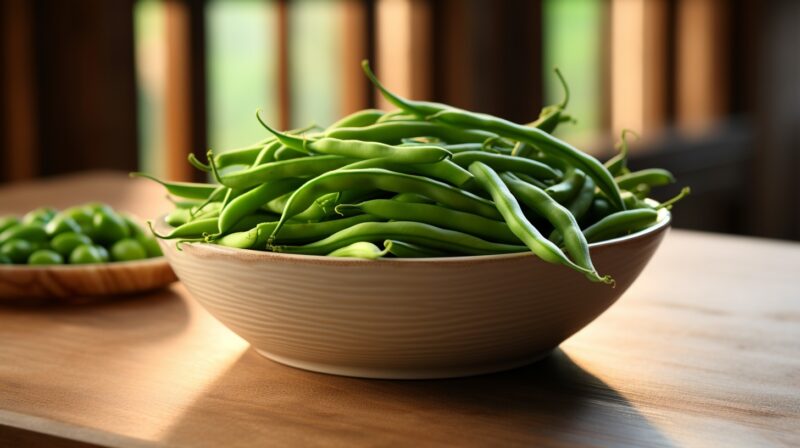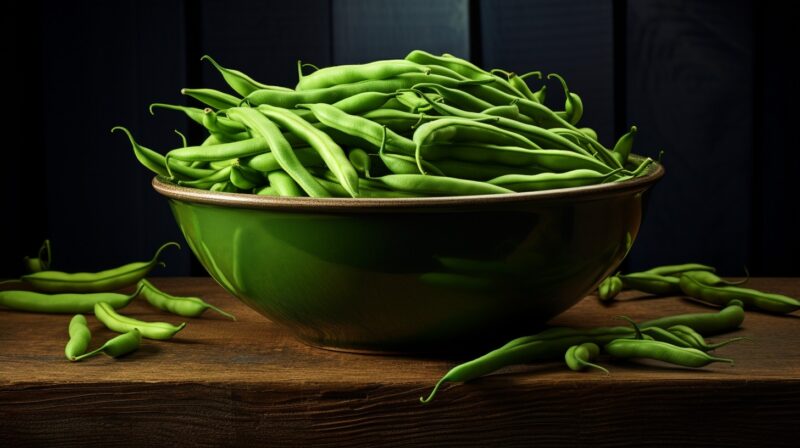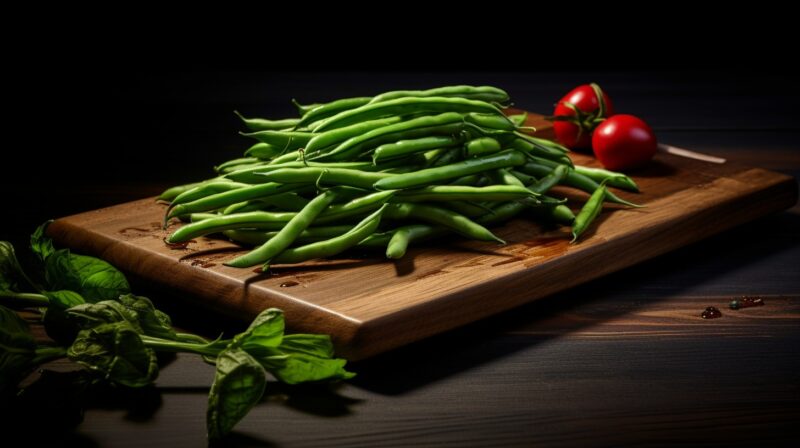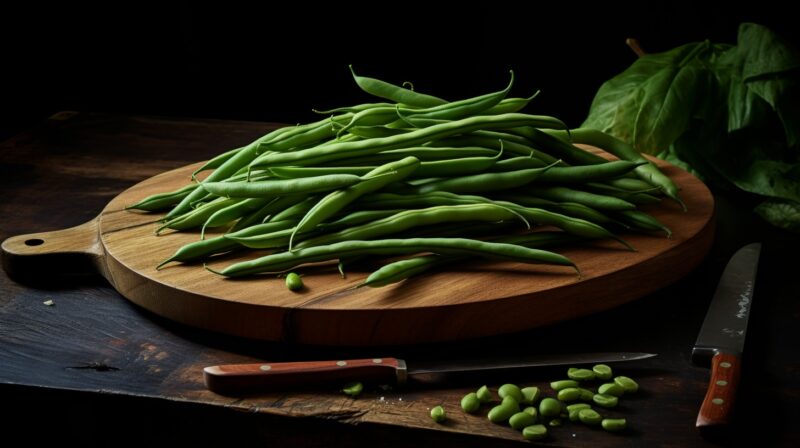In the realm of culinary exploration and health-conscious eating, a question that often surfaces is whether green beans can be consumed raw. This seemingly straightforward inquiry opens the door to a broader understanding of nutritional benefits, potential risks, and culinary practices.
In this guide, I’ll walk you through the layers of this topic, so let’s begin.
The Nutritional Profile of Raw Green Beans
Green beans, a staple in many diets, are laden with an array of nutrients that are beneficial to our health. When consumed raw, these slender green pods offer a robust profile of vitamins, minerals, and dietary fiber.
Key nutrients include Vitamin A, Vitamin C, Vitamin K, and folic acid, alongside essential minerals like calcium, silicon, iron, manganese, potassium, and copper. These nutrients play a critical role in various bodily functions, such as bone health, blood clotting, and maintaining healthy skin and vision.

The Benefits of Dietary Fiber
Raw green beans are a rich source of dietary fiber, a crucial component for digestive health. Fiber aids in maintaining regular bowel movements, preventing constipation, and could potentially lower cholesterol levels.
Additionally, it helps in regulating blood sugar levels, making green beans a favorable option for those managing diabetes.
Antioxidant Properties
The presence of antioxidants in green beans, particularly when raw, is another vital aspect of their nutritional value. These antioxidants, such as flavonoids and carotenoids, combat oxidative stress and may reduce the risk of chronic diseases, including heart disease and some cancers.
Raw green beans, with their unaltered antioxidant profile, offer a more potent defense against these health issues.
Potential Risks and Considerations

The Presence of Lectins
One of the primary concerns with consuming raw green beans is the presence of lectins, a type of protein found in many plants. Lectins in raw beans can interfere with the absorption of certain nutrients and might cause digestive distress in some individuals.
However, it’s important to note that the lectin content in green beans is relatively low compared to other beans, such as red kidney beans.
Phytic Acid and Nutrient Absorption
Green beans contain phytic acid, a naturally occurring compound that can bind minerals and reduce their absorption. While this might sound concerning, the impact of phytic acid on mineral absorption is generally minimal, especially when consumed as part of a balanced diet.
Gastrointestinal Sensitivity
Some individuals might experience gastrointestinal discomfort, such as gas or bloating, after consuming raw green beans. This reaction is typically due to the high fiber content and varies depending on one’s digestive system.
Culinary Practices and Consumption
While raw green beans are safe to eat for most people, ensuring they are thoroughly washed and cleaned is crucial. This process removes any pesticides or contaminants and makes them more palatable.
Additionally, for those concerned about lectins or phytic acid, blanching green beans briefly can reduce these compounds without significantly impacting the nutritional value.
Integrating Raw Green Beans into Your Diet

Raw green beans can be a crisp and flavorful addition to salads, crudité platters, or as a healthy snack. Their mild flavor pairs well with various dressings and dips, making them a versatile ingredient in cold dishes.
Cooking for Enhanced Digestibility
For those who prefer or require cooked green beans due to digestive sensitivity, there are several methods to retain their nutritional value while making them easier to digest.
Steaming, sautéing, or stir-frying green beans preserve most of their vitamins and minerals while also breaking down the fibers, making them gentler on the stomach.
The Culinary Versatility of Green Beans
Green beans have a global culinary presence, often featured in diverse cuisines in both raw and cooked forms. In French cuisine, for instance, raw green beans are a key ingredient in the classic Niçoise salad, where their crisp texture complements the softer components.
Similarly, in various Asian cuisines, thinly sliced raw green beans add a crunchy element to salads and cold dishes, enhanced with bold dressings and spices.
Creative Recipe Ideas
The neutral taste of green beans makes them a fantastic canvas for a range of flavors. A simple yet delicious way to enjoy them raw is in a green bean salad, tossed with cherry tomatoes, feta cheese, and a light vinaigrette.
Alternatively, for a more exotic twist, green beans can be julienned and mixed with shredded carrots, cilantro, and a peanut or soy sauce-based dressing for an Asian-inspired salad. You can also make green bean vegan burgers, which are similar to crunchy vegan black bean burgers.
Nutrient Preservation in Cooking
While raw green beans are nutritious, cooking them can make certain nutrients more bioavailable. For example, cooking slightly increases the antioxidant activity in green beans. The key is to avoid overcooking, which can lead to significant nutrient loss.
Quick cooking methods like steaming or blanching are ideal for preserving both the nutrients and the vibrant green color of the beans.
Health Considerations and Dietary Integration
Incorporating a mix of raw and cooked vegetables into your diet is beneficial. While raw green beans offer certain advantages, cooked vegetables can provide different nutrients and are sometimes easier to digest. For instance, individuals with sensitive digestive systems might find cooked green beans more tolerable than raw.

Considering Individual Health Conditions
It’s important to tailor your diet to your specific health needs. For people with certain conditions, like irritable bowel syndrome (IBS), raw green beans might trigger symptoms. In such cases, consulting with a healthcare provider or a dietitian can help in making the best dietary choices.
The Role of Green Beans in a Balanced Diet
Green beans, whether raw or cooked, fit well into a balanced diet. They can be part of a healthy eating plan that includes a variety of fruits, vegetables, whole grains, lean proteins, and healthy fats.
Their low-calorie and high-nutrient profiles make them an excellent choice for those looking to maintain a healthy weight.
FAQs
Can eating raw green beans help with weight loss?
Yes, raw green beans can be beneficial for weight loss. They are low in calories and high in fiber, which can help you feel full and reduce overall calorie intake.
Are there any specific vitamins that are more abundant in raw green beans compared to cooked ones?
Yes, Vitamin C is more abundant in raw green beans. Cooking can reduce the Vitamin C content as it’s sensitive to heat.
Can raw green beans cause allergies?
While uncommon, it’s possible to have an allergic reaction to them. If you experience symptoms like itching or swelling after eating them, consult a healthcare professional.
Are raw green beans safe for pregnant women?
Yes, they are generally safe for pregnant women, but they should be thoroughly washed to remove any harmful bacteria. It’s always best to consult with a healthcare provider.
How long can you store raw green beans in the refrigerator?
They can be stored in the refrigerator for about 7 days. Keep them in a plastic bag in the vegetable crisper for the best freshness.
Can children eat raw green beans?
Yes, children can eat them, but they should be cut into small, manageable pieces to prevent choking hazards, especially for younger children.
Final Words
Green beans are a versatile and nutritious vegetable that can be enjoyed raw by most people. They offer a range of health benefits, from their rich nutrient content to their antioxidant properties.
However, individual preferences and health considerations should guide whether to consume them raw or cooked. Integrating green beans into your diet, whether in salads, as a snack or as a cooked side dish, can contribute significantly to your overall health and well-being.
As with any dietary choice, moderation and variety are key to reaping the most benefits while enjoying the flavors and textures that green beans have to offer.

